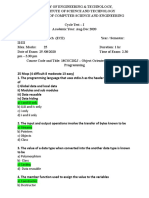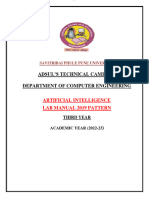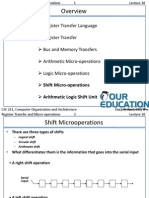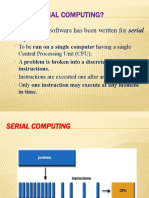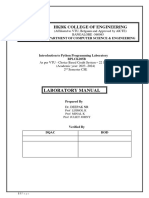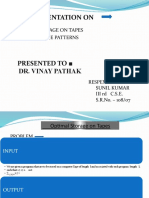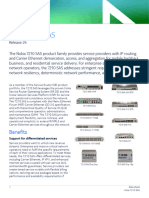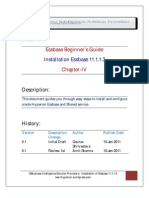CSE403 Network Security and Cryptography 12376::chetna Kwatra 3.0 0.0 0.0 3.0 Courses With Research Focus
CSE403 Network Security and Cryptography 12376::chetna Kwatra 3.0 0.0 0.0 3.0 Courses With Research Focus
Uploaded by
Paras ChadhaCopyright:
Available Formats
CSE403 Network Security and Cryptography 12376::chetna Kwatra 3.0 0.0 0.0 3.0 Courses With Research Focus
CSE403 Network Security and Cryptography 12376::chetna Kwatra 3.0 0.0 0.0 3.0 Courses With Research Focus
Uploaded by
Paras ChadhaOriginal Description:
Original Title
Copyright
Available Formats
Share this document
Did you find this document useful?
Is this content inappropriate?
Copyright:
Available Formats
CSE403 Network Security and Cryptography 12376::chetna Kwatra 3.0 0.0 0.0 3.0 Courses With Research Focus
CSE403 Network Security and Cryptography 12376::chetna Kwatra 3.0 0.0 0.0 3.0 Courses With Research Focus
Uploaded by
Paras ChadhaCopyright:
Available Formats
Lovely Professional University, Punjab
Course Code CSE403 Course Category Course Title NETWORK SECURITY AND CRYPTOGRAPHY Courses with Research focus Course Planner 12376::Chetna Kwatra Lectures 3.0 Tutorials Practicals Credits 0.0 0.0 3.0
TextBooks Sr No T-1 Title Cryptography and Network Security Reference Books Sr No R-1 R-2 R-3 R-4 Other Reading Sr No OR-1 OR-2 OR-3 OR-4 Journals articles as Compulsary reading (specific articles, complete reference) International Journal of Applied Cryptography, http://www.inderscience.com/index.php , "Journal of Cryptographic Engineering" , http://www.springerlink.com/ , Shu-Quan Li, Yue Wu, Survey on Key Management for Multicast, Second International Conference on Information Technology and Computer Science , International Journal of Network Security, http://ijns.femto.com.tw/ , Title Cryptography and Network Security Principles and Practices Cryptography & Security Applied Cryptography Protocols, Algorithm and Source code in C Cryptography and Network Security Author William Stallings C K Shyamala, N Harini and Dr T R Padmanabhan Bruce Schneier Atul Kahate Edition 5th 1st 2nd 3rd Year 2011 2011 2007 2013 Publisher Name Pearson Wiley John Wiley & Sons McGraw-Hill Author Behrouz A. Forouzan, Debdeep Mukhopadhya y Edition 2nd Year 2010 Publisher Name M. G.Hills
Relevant Websites Sr No RW-1 RW-2 RW-3 RW-4 (Web address) (only if relevant to the course) www.stanford.edu/class/cs193i/slidesSum2004/Security.ppt theory.stanford.edu/~trevisan/books/crypto.pdf http://www.rsa.com/rsalabs/node.asp?id=2262 http://people.csail.mit.edu/rivest/Rsapaper.pdf Salient Features Stanford University Lecture Notes on Different Attacks and Security Features Stanford Lecture Notes Key Management, Application and other Terms of Cryptography Digital signature and its purpose to use
Audio Visual Aids Sr No AV-1 Virtual Labs Sr No VL-1 (VL) (only if relevant to the course) http://deploy.virtual-labs.ac.in/labs/cse29/index.php?section=List%20of %20experiments Salient Features This Page Describes Various Cryptography Algorithms (AV aids) (only if relevant to the course) http://nptel.iitm.ac.in/courses/106105031/3 Salient Features Online Vedio Lecture of IIT Madras
LTP week distribution: (LTP Weeks) Weeks before MTE Weeks After MTE Spill Over 7 7 3
Detailed Plan For Lectures
Week Number Lecture Number Broad Topic(Sub Topic) Chapters/Sections of Text/reference books Other Readings, Lecture Description Relevant Websites, Audio Visual Aids, software and Virtual Labs RW-1 RW-1 Talk about the need of security Talk about the need of security Learning Outcomes Pedagogical Tool Demonstration/ Case Study / Images / animation / ppt etc. Planned
Week 1
Lecture 1
Introduction to Cryptography (Security Mechanics) Introduction to Cryptography (Cryptographic Attacks)
T-1:Chapter 1 T-1:Chapter 1
Student Learn about the Faculty will use the security Features images Student Learn about the Faculty will use the security Features images of attack or how the attacker will attack Student Learn about the Faculty will use the security Features images of security services Student will Understand the use of Multiplicative inverse in Cryptography Student will Understand the use of Multiplicative inverse in Cryptography Faculty will prepare the PPT and images as well as use the white board to explain the concept Faculty will prepare the PPT and images as well as use the white board to explain the concept
Introduction to Cryptography (Security Goals) Lecture 2 Introduction to Cryptography (Mathematics of CryptographyInteger Arithmetic)
T-1:Chapter 1
RW-1
Talk about the different kind of attacks Talk about the mathematical concept used in cryptography
T-1:Chapter - 2
RW-2
Introduction to Cryptography (Mathematics of CryptographyInteger Arithmetic)
T-1:Chapter - 2
RW-2
Talk about the mathematical concept used in cryptography
Lecture 3
Introduction to Cryptography (Modular Arithmetic)
T-1:Chapter-2
RW-2
Discuss about the use of Understand how Mod Faculty will prepare Mod operation in operation can be useful the Video as well as Cryptography in Cryptography use the white board to explain the concept
Week 2
Lecture 4
Traditional Symmetric Key Ciphers(Introduction to Symmetric Key Cipher)
T-1:Chapter-3
RW-2
Discussion about the shared Keys and Encryption using keys and different kind of attack Discussion about the substition of letters in message
Student will learn about the shared key Encryption
Faculty will use the video
Lecture 5
Traditional Symmetric Key Ciphers(Substitution Ciphers)
T-1:Chapter-3
OR-2 RW-2
Learn the simple Faculty will prepare Encryption Techniques the video as well as explain the example on white board
Lecture 6
Traditional Symmetric Key Ciphers(Substitution Ciphers)
T-1:Chapter-3
OR-2 RW-2
Discussion about the substition of letters in message
Learn the simple Faculty will prepare Encryption Techniques the video as well as explain the example on white board
Week 3
Lecture 7
Traditional Symmetric Key Ciphers(Transposition Ciphers)
T-1:Chapter -3
RW-2
Discussion about the Student will learn Use of white board to Permutation of letters in Permutation of letters in explain the examples a message Message and form the Cipher Discussion about the Mathematical Concept used in Symmetric Key Cryptography Discussion about the Mathematical Concept used in Symmetric Key Cryptography Explanation on the details behind DES Algorithm Explanation of the rounds in DES Algorithm The Strength of DES Algorithm Student will learn Faculty will use the about the Group Theory video as well as and fields images Student will learn the use of Galois Field Use of white board to explain the examples
Lecture 8
Traditional Symmetric Key Ciphers(Mathematics of Symmetric Key Cryptography Algebraic structures) Traditional Symmetric Key Ciphers(GF(2n) field)
T-1:Chapter-4
OR-2 RW-2
Lecture 9
T-1:Chapter-4
OR-1 RW-2
Week 4
Lecture 10
Data Encryption Standard (DES) and Advanced Encryption Standard (AES)(Introduction to DES) Data Encryption Standard (DES) and Advanced Encryption Standard (AES)(Structure of DES) Data Encryption Standard (DES) and Advanced Encryption Standard (AES)(Security of DES)
R-1:Chapter-3
RW-2
Understand the goal behind the DES algorithm
Faculty will use the images and animation
R-1:Chapter-3
RW-2
Students will Faculty will use the understand the detailed images and animation design of DES algorithm Students will Faculty will use the understand the strength images of DES algorithm against attacks Students will Faculty will use the understand the strength images of DES algorithm against attacks Students will Faculty will use the understand the detailed images and animation design of DES algorithm
R-1:Chapter-3
RW-2
Lecture 11
Data Encryption Standard (DES) and Advanced Encryption Standard (AES)(Security of DES) Data Encryption Standard (DES) and Advanced Encryption Standard (AES)(Structure of DES)
R-1:Chapter-3
RW-2
The Strength of DES Algorithm
R-1:Chapter-3
RW-2
Explanation of the rounds in DES Algorithm
Week 4
Lecture 11
Data Encryption Standard (DES) and Advanced Encryption Standard (AES)(Introduction to DES)
R-1:Chapter-3
RW-2
Explanation on the details behind DES Algorithm
Understand the goal behind the DES algorithm
Faculty will use the images and animation
Lecture 12
Data Encryption Standard (DES) and Advanced Encryption Standard (AES)(Introduction to AES)
T-1:Chapter-7
RW-2
Basics of AES algorithm Understanding of the and the advancements need of AES
Faculty will use the images
Week 5
Lecture 13
Data Encryption Standard (DES) and Advanced Encryption Standard (AES)(Transformation in AES)
T-1:Chapter-7
RW-2
Detailed structure of AES
Understand the design and detail of AES
Faculty can use the animation
Lecture 14
Data Encryption Standard (DES) and Advanced Encryption Standard (AES)(Key expansion in AES) Data Encryption Standard (DES) and Advanced Encryption Standard (AES)(AES Cipher)
T-1:Chapter-7
RW-2
Key generation in each round of AES
Student will understand Faculty can use the key generation phases animation in AES Student will understand Faculty can use the encryption of message animation through AES Faculty will use the video as well as solve the example in white board
T-1:Chapter-7
RW-2
Discussion about the generation of cipher text through AES
Lecture 15
Mathematics of Asymmetric-Key Cryptography(Prime Number)
T-1:Chapter-9
OR-2 RW-2
Discuss the use of prime Understand the numbers in the field of Application of Prime cryptography numbers in Cryptography The use of Chinese Remainder Theorem in Cryptography Explain how the security strength of a cryptographic algorithm is measured Term Paper,Test1
Week 6
Lecture 16
Mathematics of Asymmetric-Key Cryptography(Chinese Remainder Theorem) Mathematics of Asymmetric-Key Cryptography(Discrete Logarithm)
T-1:Chapter-9
RW-2
Student will understand Faculty will use the white board as well as the Application of video Chinese theorem Student will Understand Faculty will use the how the security image strength of a cryptographic algorithm is measured Student will Understand Faculty will use the the need of keys and images their significance in cryptosystems Faculty will use the video as well as solve the example in white board
T-1:Chapter-9
RW-2
Lecture 17 Lecture 18 Asymmetric Key Cryptography (Introduction to Asymmetric Key Cryptography) Asymmetric Key Cryptography (RSA cryptosystems) T-1:Chapter - 10 OR-1 RW-2
To distinguish between symmetric-key and asymmetric-key cryptosystems
Week 7
Lecture 19
T-1:Chapter - 10
OR-1 RW-2
Explanation of the basic Student will Understand public how the Message can Key Algorithm RSA be encrypted through RSA Explanation of key distribution techniques
Lecture 20
Key Management(Symmetric key distribution) Key Management(Symmetric key agreement)
T-1:Chapter-15
OR-3 RW-3 OR-3 RW-3
Understand how the Faculty will use video keys will be distributed and images to the users
T-1:Chapter-15
Explanation of common Student will understand Faculty will use video key sharing between the the method to generate and images users the common key
Week 7
Lecture 21
Key Management(Public Key Distribution)
T-1:Chapter-15
OR-3 RW-3
How the Secret Key will Method to distribute the Faculty will use the be distributed through key video,images Public Key
MID-TERM
Week 8 Lecture 22 Message Integrity and Authentication(Message integrity) Message Integrity and Authentication(Message Authentication) Message Integrity and Authentication(Introduction to Cryptographic Hash Functions) T-1:Chapter-11 OR-4 RW-3 OR-2 Importance of Integrity in Message Discussion on different scenarios for message authentication Explanation of the basic Hash functions used to maintain the Integrity of Message Student will understand Faculty will use importance of message images integrity Student will learn the Faculty will use importance of message images authentication Student will learn how Faculty can use different hash functions video/images maintain the Integrity of message
Lecture 23
T-1:Chapter-11
Lecture 24
R-1:Chapter-11
RW-2 RW-3
Week 9
Lecture 25
Message Integrity and Authentication(SHA 512) Message Integrity and Authentication(SHA 512) Message Integrity and Authentication(SHA 512) Digital Signature(Comparison with Conventional Signature)
R-1:Chapter-11
RW-2
Talk about structure and Student will understand Faculty will use the design detail of SHA the structure and images working of SHA Talk about structure and Student will understand Faculty will use the design detail of SHA the structure and images working of SHA Talk about structure and Student will understand Faculty will use the design detail of SHA the structure and images working of SHA Comparison of digital and conventional signature Student will understand Faculty will use the difference between images digital signature and conventional signature and the reason for using DS
Lecture 26
R-1:Chapter-11
RW-2
Lecture 27
R-1:Chapter-11
RW-2
Week 10
Lecture 28
T-1:Chapter-13
RW-4
Digital Signature(Process of Digital Signature)
T-1:Chapter-13
RW-4
How the digital signature Student will understand Faculty will use the will be formed for a the generation of digital images and can take message signature for a message the help from nptel website vedio also How the digital signature Student will understand Faculty will use the will be formed for a the generation of digital images and can take message signature for a message the help from nptel website vedio also Talk about the security features achieved by digital signature Term Paper,Test2 Student will understand Faculty will use the the significance of images and can take digital signature the help from nptel website vedio also Student will understand Faculty will use the the various algorithm of images and can take digital signature the help from nptel website for video
Lecture 29
Digital Signature(Process of Digital Signature)
T-1:Chapter-13
RW-4
Lecture 30
Digital Signature(Services Provided by Digital Signature)
T-1:Chapter-13
RW-4
Week 11
Lecture 31 Lecture 32 Digital Signature(Digital Signature Schemes) T-1:Chapter-13 RW-4
Explain various algorithms to generate the digital signature
Week 11
Lecture 33
Digital Signature(Digital Signature Schemes)
T-1:Chapter-13
RW-4
Explain various algorithms to generate the digital signature Explanation of different modes of IP security Dicussion on authentication header and ESP Protocol Dicussion on authentication header and ESP Protocol Discuss about the security association formed between applications Discuss about security policy formed between applications Discussion on Email architecture
Student will understand Faculty will use the the various algorithm of images and can take digital signature the help from nptel website for video Student will understand Faculty will use the tunnel mode and images transport mode of IPSec Student will learn the security protocols of IPsec Student will learn the security protocols of IPsec Faculty will use the images Faculty will use the images
Week 12
Lecture 34
Security at Network Layer: IPsec (Modes of IPSec) Security at Network Layer: IPsec (Two Security Protocols of IPSec) Security at Network Layer: IPsec (Two Security Protocols of IPSec) Security at Network Layer: IPsec (Security Association)
T-1:Chapter-18
RW-2
Lecture 35
T-1:Chapter-18
RW-2
Lecture 36
T-1:Chapter-18
RW-2
Week 13
Lecture 37
T-1:Chater-18
RW-2
Student will understand Faculty will use the importance of security images association Student will understand Faculty will use the details of security images Policy Students will understand the structure of an email application and security applied on it. Students will understand the structure of an email application and security applied on it. Students will learn the architecture of PGP Students will learn the architecture of PGP Faculty will use the images and can take the help from nptel website vedio Faculty will use the images and can take the help from nptel website vedio Faculty will use the images Faculty will use the images
Lecture 38
Security at Network Layer: IPsec (Security Policy) Security at Application Layer (Email)
T-1:Chapter-18 R-1:Chapter-19 T-1:Chapter-16
RW-2
Lecture 39
RW-2
Week 14
Lecture 40
Security at Application Layer (Email)
T-1:Chapter-16
RW-2
Discussion on Email architecture
Lecture 41 Lecture 42
Security at Application Layer (PGP) Security at Application Layer (PGP)
T-1:Chapter-16 T-1:Chapter-16
RW-2 RW-2
Discussion on Pretty Good Privacy Discussion on Pretty Good Privacy
SPILL OVER
Week 15 Lecture 43 Lecture 44 Lecture 45 Spill Over Spill Over Spill Over
Scheme for CA:
Component Term Paper,Test Frequency 2 Total :Out Of 3 Each Marks Total Marks 10 10 20 20
Details of Academic Task(s)
AT No. Objective Topic of the Academic Task Nature of Academic Task (group/individuals/field work Individual Evaluation Mode Allottment / submission Week 5/6
Test1
To evaluate the Syllabus covered till week 5 knowledge of students based on the syllabus covered
The answers of the students will be evaluated on the basis of correctness, precision and relevance. The answers of the students will be evaluated on the basis of correctness, precision and relevance. The term paper will be evaluated on the basis of content and viva/presentation
Test2
To evaluate the Syllabus Covered till week 10 knowledge of students on the basis of the syllabus taught Students will apply their skills in reference to their learning of course and write a review paper. Students will learn to write the technical paper on the basis of cryptographic algorithms taught so far. Students may also be expected to implement the topics as per faculty's suggestions.
Individual
10 / 11
Term Paper1
Individual
3 / 12
List of suggested topics for term paper[at least 15] (Student to spend about 15 hrs on any one specified term paper) Sr. No. Topic 1 Security services X.800 2 Basic substitution Encryption techniques (Ceaser, Playfair, Mono/Poly-Alphabetic) 3 Transposition Encryption techniques 4 Playfair cipher with GUI support 5 Hill cipher 6 Vigenere cipher 7 One time pad 8 Fiestal cipher 9 Stream generation process in RC4 10 RSA algorithm 11 Man in the middle attack in Diffie Hellman key exchange 12 Implementation of Digital signature 13 Euler's Function
14 Eucludian Algorithm 15 Fermat's Theorem 16 RSA Digital Signature 17 Schnorr Digital Signature 18 Digital Signature Standard 19 Modulus calculation 20 Pseudo Ramdom Number Generator 21 Majority function in SHA-512 22 Conditional Function in SHA-512 23 Computation of Primitive root in group 24 Key Stream generation using RC4 25 Chinese Remainder Theorem 26 Meet In Middle Attack in 3DES 27 Blow fish algorithm 28 Implementation of Brute Force Attack
You might also like
- BSBTWK502: Manage People PerformanceDocument9 pagesBSBTWK502: Manage People Performancestar trendzNo ratings yet
- Cryptography & Network Security Lab: Paper Code (Etit-455)Document70 pagesCryptography & Network Security Lab: Paper Code (Etit-455)rapriaabhijeetNo ratings yet
- Iot Brochure PDFDocument15 pagesIot Brochure PDFdian ariaNo ratings yet
- Little Yarn Friends - Crochet Pattern - Lil' Fluffy Unicorn (Despicable..Document7 pagesLittle Yarn Friends - Crochet Pattern - Lil' Fluffy Unicorn (Despicable..Eunice100% (3)
- American GodsDocument6 pagesAmerican GodsTee R TaylorNo ratings yet
- (CE-408) CIS-Theory+Lab Course-Fall-2022Document8 pages(CE-408) CIS-Theory+Lab Course-Fall-2022nawal 109No ratings yet
- Open SourceDocument6 pagesOpen SourceheenachibbNo ratings yet
- CSE304 SyllabusDocument2 pagesCSE304 SyllabusBhavesh BansalNo ratings yet
- IS Lab MannualDocument26 pagesIS Lab Mannualvasudha sankpalNo ratings yet
- Text Summarization On Youtube Videos in Educational DomainDocument5 pagesText Summarization On Youtube Videos in Educational DomainMR. SIDDHESH KATHALENo ratings yet
- Cloud Computing Unit-2 (A)Document23 pagesCloud Computing Unit-2 (A)nabeelNo ratings yet
- Traffic Sign Board Recognition and Voice Alert System Using Convolutional Neural NetworkDocument1 pageTraffic Sign Board Recognition and Voice Alert System Using Convolutional Neural NetworkWebsoft Tech-HydNo ratings yet
- Java Lab ProgramsDocument18 pagesJava Lab ProgramsKarthi KarthickNo ratings yet
- Macro ProcessorDocument44 pagesMacro ProcessorDanielLuci100% (1)
- M.tech Project Documentation Guidelines& CertificatesDocument8 pagesM.tech Project Documentation Guidelines& CertificatesMahesh NeelarapuNo ratings yet
- Elitmus Sample Papers IDocument6 pagesElitmus Sample Papers IPriyanshu SinhaNo ratings yet
- Ns 5Document28 pagesNs 5Harsha GangwaniNo ratings yet
- 18csc202j Oodp Ct1 Question-OldDocument8 pages18csc202j Oodp Ct1 Question-OldBergin PremNo ratings yet
- Python Hands On Practice Lesson 6-9Document18 pagesPython Hands On Practice Lesson 6-9AmrishmuruganNo ratings yet
- AI Lab ManualDocument37 pagesAI Lab ManualNeha KardileNo ratings yet
- CSharp-OOP-Working-with-Abstraction-ExerciseDocument10 pagesCSharp-OOP-Working-with-Abstraction-ExerciseBob LongNo ratings yet
- UNIT-III Inheritance, Interfaces, Packages and Exception HandlingDocument63 pagesUNIT-III Inheritance, Interfaces, Packages and Exception Handlingdil rockNo ratings yet
- Lab ManualDocument57 pagesLab ManualADITYA S NIRGUNDNo ratings yet
- TCS Smart Hiring Roadmap 2024 by Knowledge GateDocument29 pagesTCS Smart Hiring Roadmap 2024 by Knowledge Gatemahendragharad5No ratings yet
- MSBTE JAVA 9113 Question PaperDocument10 pagesMSBTE JAVA 9113 Question PaperManoj KavediaNo ratings yet
- Python Programming Quiz 1Document14 pagesPython Programming Quiz 1Shivam PandeyNo ratings yet
- Guidelines For Technical Seminar ReportDocument6 pagesGuidelines For Technical Seminar ReportKaranNo ratings yet
- A Framework For Deepfake V2Document24 pagesA Framework For Deepfake V2Abdullah fawaz altulahiNo ratings yet
- DAA Unit 3Document23 pagesDAA Unit 3Loganayagi PNo ratings yet
- Six Week Summer Training Report: Object Oriented Programming Using Java Course Code-Cse343Document19 pagesSix Week Summer Training Report: Object Oriented Programming Using Java Course Code-Cse343ponnaganti tejaNo ratings yet
- Constructor in Inheritance PDFDocument12 pagesConstructor in Inheritance PDFNaveenNo ratings yet
- Bitszc463 Sep22 FNDocument2 pagesBitszc463 Sep22 FNpkjmesraNo ratings yet
- Vtunotesbysri: Module 2: Transport LayerDocument49 pagesVtunotesbysri: Module 2: Transport LayerSakshiNo ratings yet
- Project PPT 1Document16 pagesProject PPT 1Ritik KumarNo ratings yet
- Vu Study M Parallel and Distributed ComputerDocument29 pagesVu Study M Parallel and Distributed ComputerVanita MangtaniNo ratings yet
- FinalDocument28 pagesFinalKowshik PonugotiNo ratings yet
- Shift Micro-OperationsDocument8 pagesShift Micro-Operationsoureducation.in100% (5)
- 5-Days FDP Data Science: Aicte Training and Learning (Atal) AcademyDocument3 pages5-Days FDP Data Science: Aicte Training and Learning (Atal) AcademySumit Majumdar100% (1)
- Project On Car AnimationDocument48 pagesProject On Car AnimationJaskaran Fishery fishNo ratings yet
- JDBC Api Components and DriversDocument15 pagesJDBC Api Components and Driversaa bbNo ratings yet
- Python Study MaterialDocument11 pagesPython Study MaterialSneha SheteNo ratings yet
- What Is Serial Computing?: Traditionally, Software Has Been Written For Serial ComputationDocument22 pagesWhat Is Serial Computing?: Traditionally, Software Has Been Written For Serial ComputationDivya NigamNo ratings yet
- LAB MANUAL Java CS406 FORMATDocument9 pagesLAB MANUAL Java CS406 FORMATNidhi KhireNo ratings yet
- Department of Computer Engineering: Mini Project Report On " Covid-19 Tracker Using Python "Document17 pagesDepartment of Computer Engineering: Mini Project Report On " Covid-19 Tracker Using Python "Akshay KhebadeNo ratings yet
- Simulation of Congestion Control Algorithm AimDocument4 pagesSimulation of Congestion Control Algorithm AimHaru HarshuNo ratings yet
- Virtual IzationDocument3 pagesVirtual Izationaravindan476No ratings yet
- Updated 5th and 6th Sem 2021 Scheme and SyllabusDocument71 pagesUpdated 5th and 6th Sem 2021 Scheme and Syllabusdmprashanth6No ratings yet
- CS6513-COMPUTER GRAPHICS LABORATORY-664424542-computer Graphics Lab Manual 2013 RegulationDocument77 pagesCS6513-COMPUTER GRAPHICS LABORATORY-664424542-computer Graphics Lab Manual 2013 RegulationGanesh100% (1)
- Ajay ReddyDocument23 pagesAjay ReddyGandavadi Venkatesh100% (1)
- Opening Report - (2023-24) - DSTL - BCS303Document2 pagesOpening Report - (2023-24) - DSTL - BCS303Ayushi ChaudharyNo ratings yet
- BPLCK205B Manual (23-24)Document25 pagesBPLCK205B Manual (23-24)deeptikantapanigrahi45No ratings yet
- Appu ReoprtDocument23 pagesAppu ReoprtApoorva AppuNo ratings yet
- DCN SyllabusDocument1 pageDCN SyllabusHimanshu ChauhanNo ratings yet
- Programming With Python - PGDBDA - Feb20Document26 pagesProgramming With Python - PGDBDA - Feb20AKSHAY WADITKENo ratings yet
- WT 1 AssignmentDocument18 pagesWT 1 AssignmentdineshNo ratings yet
- OopsDocument23 pagesOopsJanani GowdaNo ratings yet
- Assignment 2 (SPOS) EditedDocument12 pagesAssignment 2 (SPOS) EditedOmkar ThangeNo ratings yet
- Steganography Project Report For Major Project in B TechDocument74 pagesSteganography Project Report For Major Project in B Techablond2No ratings yet
- VB New NotesDocument91 pagesVB New Notesraj kumarNo ratings yet
- "Hospital Management System": Project Report OnDocument19 pages"Hospital Management System": Project Report OnGarry KmrNo ratings yet
- Presentation On: Presented To Dr. Vinay PathakDocument37 pagesPresentation On: Presented To Dr. Vinay Pathakapi-1998177989% (19)
- Network Management System A Complete Guide - 2020 EditionFrom EverandNetwork Management System A Complete Guide - 2020 EditionRating: 5 out of 5 stars5/5 (1)
- Class 9 Part B Unit 1 ExercisesDocument5 pagesClass 9 Part B Unit 1 ExercisesChinna SamyNo ratings yet
- Example: Configuring A Stateless Firewall Filter On An Interface Group - Juniper NetworksDocument1 pageExample: Configuring A Stateless Firewall Filter On An Interface Group - Juniper Networks王鴻升No ratings yet
- NAVTechDays2019 - Make The Most Out of Business Central On DockerDocument45 pagesNAVTechDays2019 - Make The Most Out of Business Central On Dockerbogdan enescuNo ratings yet
- GnsDocument1 pageGnsWeizhao ZhangNo ratings yet
- Fourth Periodic Test in Epp - Tle 6Document5 pagesFourth Periodic Test in Epp - Tle 6ShenSy89% (18)
- Javascript HandbookDocument171 pagesJavascript HandbookMarko Petrović100% (1)
- Owid Covid DataDocument2,054 pagesOwid Covid DataBernardo RequeNo ratings yet
- 3 Month Marketing PlanDocument23 pages3 Month Marketing PlanImSiggyNo ratings yet
- Hot Standby Router Protocol: TopologyDocument8 pagesHot Standby Router Protocol: TopologyFrancisco HerreraaNo ratings yet
- Teste Ethernet Loopback PDFDocument10 pagesTeste Ethernet Loopback PDFwernerkaiNo ratings yet
- Nokia 7210 SAS Data Sheet ENDocument12 pagesNokia 7210 SAS Data Sheet ENYoon 123No ratings yet
- Oviya Darnal - Age, Height, Net Worth, Boyfriend, Age, Family 2021Document7 pagesOviya Darnal - Age, Height, Net Worth, Boyfriend, Age, Family 2021Servesh KumarNo ratings yet
- GPON Mobile BackhaulDocument48 pagesGPON Mobile BackhaulWiswanto Wae100% (2)
- What Is OFDMDocument39 pagesWhat Is OFDMRenu PareekNo ratings yet
- Check Out Some of These Simple Video Marketing TipsDocument2 pagesCheck Out Some of These Simple Video Marketing TipsHerreraHolcomb81No ratings yet
- Practical No 1 19.05Document3 pagesPractical No 1 19.05Naman GuptaNo ratings yet
- CA Brand Standards ManualDocument288 pagesCA Brand Standards ManualBill YoungNo ratings yet
- T Rec G.8261 201308 I!!pdf eDocument116 pagesT Rec G.8261 201308 I!!pdf egcarreongNo ratings yet
- Cyberpower Ds Sm20kapmx Sm120-200kamfx en v1Document2 pagesCyberpower Ds Sm20kapmx Sm120-200kamfx en v1Kibsain LunaNo ratings yet
- Marshall MacluhanDocument20 pagesMarshall MacluhanUmaima EjazNo ratings yet
- Learning Management System (LMS) : USER Manual Version 6.0: Sl. No Version History DateDocument19 pagesLearning Management System (LMS) : USER Manual Version 6.0: Sl. No Version History Datevrashank sharmaNo ratings yet
- Essbase Installation 11.1.1.3 ChapterDocument24 pagesEssbase Installation 11.1.1.3 ChapterAmit SharmaNo ratings yet
- Don Trust Me 2Document9 pagesDon Trust Me 2Ashley WilliamsNo ratings yet
- Chapter 7 - Telecommunications, The Internet, and Wireless TechnologyDocument13 pagesChapter 7 - Telecommunications, The Internet, and Wireless TechnologyHASNAT ABULNo ratings yet
- Client Access List 20191023Document144 pagesClient Access List 20191023DardsNo ratings yet
- A Signal-to-Interference Ratio Based Downlink Scheduling Scheme For WCDMA Mobile Communication SystemDocument6 pagesA Signal-to-Interference Ratio Based Downlink Scheduling Scheme For WCDMA Mobile Communication SystemrezadigitNo ratings yet



















